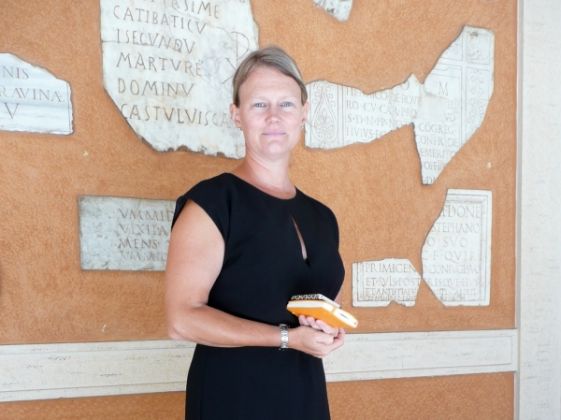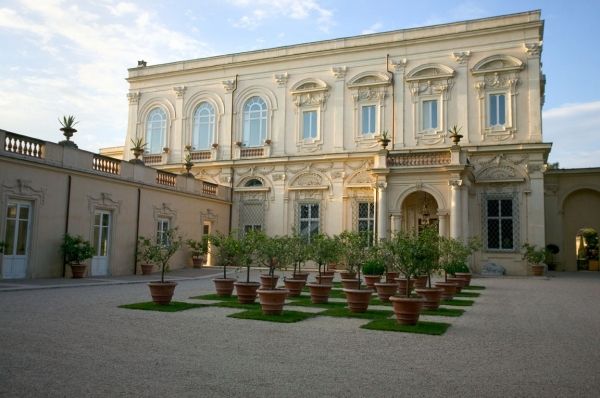Archaeologist Kimberly Bowes talks about the AAR's policies, programmes and its history
If we can presume that foreign academies reflect the spirit of the nations they represent, the American Academy in Rome (or the AAR, as it is commonly called) is a shining example. Its towering wrought iron gates, formal early 20th-century façade and classical columned quadrangle enclose a hive of activity, with fellows and staff working purposefully around the airy rooms and corridors.
"This is a very busy moment," says new director Kimberly Bowes, who took up the post at the beginning of this summer. "We have a full programme ahead of over 90 events – exhibitions, concerts, lectures, field trips, readings, discussions on contemporary issues and so on. Many of these are in collaboration with Italian institutions and other foreign academies, and two thirds are open to the public. We encourage our fellows to interact with Rome and not to be isolated. We are also involved in helping them to make contacts and find outlets for their work."
Throwing open its doors to Rome and the outside world is a cornerstone of the Academy's policy. An average of 30 Rome Prize Fellows, selected by rotating independent juries, are hosted by the Academy each year for periods of study that vary from six months to up to two years. In addition, the AAR annually welcomes five Italian Fellows – known as Affiliated Fellows – three in the arts and two in the humanities.
The intellectual leaders of the AAR – the director of the Academy, along with directors in humanities and the arts – typically serve a three-year term in order to guarantee a regular turnover of new ideas, while permanent staff keep the wheels running smoothly.
"We are the only one of Rome's 34 foreign academies to be wholly privately financed," Bowes explains.
The foundations of the AAR were first laid in 1894 with private money put up by a group of businessmen and benefactors led by architect Charles F. McKim, inspired by the surge of interest in European architecture and antiquities aroused by exhibits at the Chicago World Fair. The Academy began life as the American School of Architecture. Three years later, it was transformed into the American Academy in Rome, making it one of the first foreign academies set up in the city. The project attracted the sponsorship of most of the doyens of US high finance such as the Carnegie Foundation, J.P. Morgan, McKim, Harvard College, the Rockefeller Foundation, William K. Vanderbilt, Henry Walters and others.
In 1912 it merged with the American School of Classical Studies to form the institution that exists today on the Gianicolo hill. The main McKim, Mead & White building, named after the architecture firm responsible for building it, has two separate departments. One is devoted to the arts – including music and literature – and the other to the humanities. In addition, the Academy possesses the palatial 17th-century Villa Aurelia, bequeathed by Philadelphia heiress Clara Jessup Heyland in 1909. Situated just across the road, it is used for formal receptions and events.
Bowes is the Academy's 22nd director. An archaeologist and university professor, she has a dazzling curriculum vitae that includes study or lecturing posts at some of the top US academic institutions, with a PhD from Princeton, appointments as a postdoctoral fellow/lecturer at Yale, visiting pre-fellow at Harvard, assistant professorships at Fordham and Cornell, and her present appointment as Associate Professor of Classical Studies at the University of Pennsylvania.
"The university has very kindly given me leave of absence to let me take up this post," she explains.
Kim – as her colleagues call her – is not new to Rome. She was a fellow herself in 2006 and for the past two years she has served as the Andrew W. Mellon Professor in Charge of the School of Classical Studies, the humanities arm of the Academy.
The last few years have seen her deeply involved in "The Peasant Project", a revolutionary archaeological campaign centred in Cinigiano in the Maremma area of Tuscany and aimed at exploring the lifestyle, diet and habits of the rural poor of the ancient Roman world.
"We didn't know at all what to expect and there were plenty of surprises. We uncovered remains of all kinds of constructions, like farm buildings, animal outhouses, oil presses, drainage systems and so on, as well as a lot of objects. We hadn't expected poor people to have access to the same consumer goods as rich people. But they did. The only difference was that they had less of them. We also found traces of seeds and pollen that suggests their use of crop rotation."
She says that during the next three years as AAR director, she will have to carve out time to write her book about the discoveries. "If archaeologists don't publish their findings it's as if these sites never existed,” said Bowes. “There's very little difference between an unpublished excavation and a looted site – we have a moral responsibility to present our findings to the public.”
What first sparked off her interest in archaeology? "I think it was when I went to Guatemala with my parents, when I was about ten. They were amateur bird watchers and they took me all over the world following their passion. Climbing up the steps of the Tikal Temples made a huge impression on me."
AAR fellows enjoy other privileges besides the nurturing of their talents. The academy also supports a sustainable food programme, in part produced in its own garden.
"Our grounds include 11 acres of organically cultivated gardens. Our last president, Adele Chatfield-Taylor, invited the celebrated Californian chef Alice Waters, vice president of Slow Food International, to create our food programme. We bring over chefs from the US to explore Italian sustainable food traditions. They also cook for the Academy guests, with large family-style meals fostering our collaborative environment."
Margaret Stenhouse
General Info
View on Map
The American Academy gets new director
American Academy in Rome, Via Angelo Masina 5, tel. 065846412, www.aarome.org
























